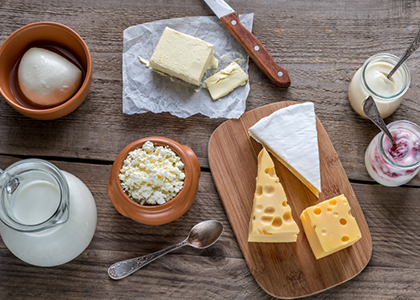
The Dairy Diary: Why More People Are Opting Out
By Claire Georgiou, Reboot Naturopath, B.HSc ND
What do most people think of when they think of filling up on calcium for bone health? It’s almost always milk and cheese. We have been told for many decades that the only way to promote bone health and reduce the incidence of osteoporosis is to drink and consume 3 servings of dairy per day! There are more and more findings that this may not be the case at all! Several studies that I point out throughout this article indicate that dairy consumption seems to have very little to do with long-term bone health. The recommendations to consume 1,000mg of calcium per day are now being questioned, as most studies that make this point are only short-term and cultures that consume much less calcium naturally have lower incidences of osteoporosis.
People are consuming less dairy, here are some of the reasons why:
Altered Gut Health
This is occurring for a number of reasons from an altered gut microbiome due to environmental influences such as processed foods, sugar, alcohol, lack of fermented foods in the diet, medications, antibiotics, and contraceptives and more. This then reduces our digestive ability and influences our immune system and the way we react to foods.
Food Allergies and Intolerances
Flatulence, gas, reflux, indigestion, bloating, diarrhoea, constipation eczema, asthma, skin rashes, congestion, phlegm, sinusitis, and headaches are all symptoms of food allergies and/or food intolerances, and some of these may come from too much dairy consumption.
Awareness
People are becoming more aware of what’s normal and what’s not so normal in terms of their health and comfort after food consumption. Once upon a time children who felt sick after a glass of milk were told to just drink their milk anyway because it was good for them, but times have changed. We pay more attention to how we react with food and we understand that it isn’t necessarily right for everyone.
Increases in Factory Farming Processes
The animal farming environment has become more of a processing plant and is moving further away from how Mother Nature intended it to be. The possible living conditions of the animal coupled with feeds that are laced with growth promotants, medications that are given to effect the amount of milk they produce, antibiotics to avoid infections; this all determines and influences the quality of the milk.
Some researchers at the Medical University of Yamanashi have hypothesised, that modern industrial milk production practices have changed hormone composition of milk in ways that could increase the risk of hormone-related cancers.
Ethical and Humane Choices
Many people are choosing to avoid or lower their consumption of animal foods and reduce their impact on the planet. People are also becoming more aware and are choosing to move away from highly processed factory farmed animal products.
Lowering Calorie and Saturated Fat Intake
People are choosing lower calorie and lower saturated fat options such as almond milk, hemp seed milk, hazelnut milk, quinoa milk, coconut milk (diluted) and rice milk. These milks can be easier and lighter on the digestive system and supportive of weight control.
Cultural
Many cultures, such as Asian cultures, that previously did not include dairy as a normal part of their traditional diet are now consuming dairy as they move towards a more standard western diet to then find out that it isn’t necessarily right for them. People are unfortunately eating less of their traditionally prepared meals to a more processed SAD diet.
Taste
Since it’s not just dairy milk as a choice, we now have the option to choose if we prefer the taste of almond milk versus the taste of cow’s milk and some people certainly prefer milk alternatives.
Cancer Risk
There are a number of studies that indicate the possible connection between dairy consumption and cancer risk. In a study at the Harvard School of Public Health showed that a modest elevation in the risk of ovarian cancer was seen for lactose intake at the level that was equivalent to 3 or more servings of dairy per day. In a Harvard study of male health professionals, men who drank two or more glasses of milk a day were almost twice as likely to develop advanced prostate cancer as those who didn’t drink milk at all.
Where Else To Get Calcium?
Calcium can also be found in dark green, leafy vegetables, such as kale, arugula, broccoli and collard greens, as well as oatmeal, almonds, seafood, white beans, dried figs, and other nuts, seeds and legumes.
We have a number of excellent dairy free choices along with high calcium juice options:
- Almond Cheese (my personal favourite)
- Vegan Parmesan cheese
- Cashew Cream
- Almond milk
- Brazil milk
- Calcium-Rich Cucumber Juice
- Get your Greens and Protein Juice
- Vanilla Tahini Shake It
More about milk, dairy and calcium:
Truth about Calcium
Why You Don’t Need Milk
The Milk Myth Debunked
What Dairy Alternatives Give You Calcium
5 Nutrients that Boost Bone Health.